13
The Corps
Vignettes of Portsea Life
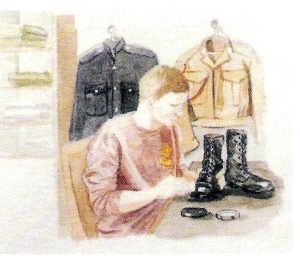
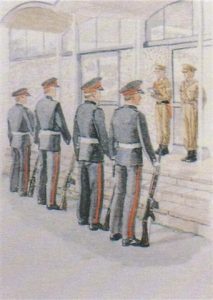
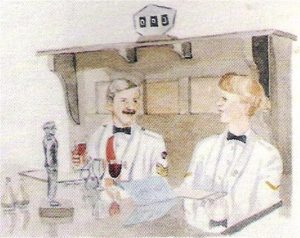
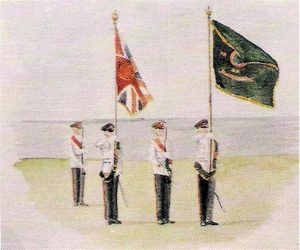
Artist: Bryce Parry
OCS Scrapbook 1985
On 29 March 1969 the Military Board approved formation of a Corps called the Company of Officer Cadets. While this move may have been a surprise to some, as the title had been in common use since its gazettal in 1952, the Secretary to the Military Board explained somewhat clumsily that the title was previously a generic term not specifically related to OCS. What was really meant was that the COC was now formally established as a Corps of the Army and it was included as such in Australian Military Regulation 68, third in seniority after the Australian Staff Corps and the Corps of Staff Cadets. This rather late action had been prompted by a terminology problem since 1965 when an increased student population of over 150 led to a decision to expand the existing company structure to a battalion of two companies in order to provide the internal leadership opportunities for the senior class. The initial natural move within the School was to call this revamped internal structure the Battalion of Officer Cadets, but when this sank in at Army Headquarters it sparked some specific consideration on whether it was acceptable to change the title back and forth as the numbers at the School fluctuated. It was then rationalised by a decision to formally establish a corps but still retain the original title, presumably on the basis of a more catholic reading of the word company. Whether or not this logic was tenable, the dilemma had brought attention to the discrepancy of terminology vis a vis the Corps of Staff Cadets of RMC and led to the idea of establishing the officer cadet body as a corps, so solving, at least to some minds, the problem of nomenclature (1).
The logical parallel and succinct option of Corps of Officer Cadets does not seem to have come to mind, but then again the term Company of Officer Cadets was well entrenched as a going concern. The men and latterly women who passed through the Company of Officer Cadets were a special breed. They were chosen from the better endowed elements of Australian and overseas societies on the basis of intelligence, achievement, physical fitness, moral fibre and potential leadership. Even so, some failed to meet the course standards through inability to master the mental or physical demands made on them, sometimes through lack of motivation, others through accident, and yet others who found that they were better suited to a less demanding profession. Although some could not measure up to the standards required, others found themselves out of place in such an organisation, even though recruiting advertisements at that stage had not descended to some of the present levels of minimising military activities up to the point of virtual exclusion. Even after graduation some came to realise that the realities of service life were not those which they wished to continue, or could cope with. There was no disgrace to the ones who had put in genuine effort to pass the course and simply found themselves misplaced: it was a mutual testing and assessment as well as educational environment, set to allow the Army to take on those best suited to becoming officers, and the candidates to determine if they wished to pursue a military career.
Status of the cadet officers was sometimes an awkward problem. While nominally Australian Regular Army members paid at corporal level and undertaking an army course, the nature of that course involved having officer candidates develop the feeling, responsibility and social standards of the level for which they were being prepared, so that transition to officer status was achieved during its term, rather than hoping for some sort of metamorphosis on arrival at their units wearing officer rank. A ‘gentleman cadet’ was once described as ‘almost an officer and not quite a gentleman’, an aphorism which most officers could readily accept on thinking back to their own period of incarceration. Staff members tried their best to inculcate the ethos of leadership, responsibility, knowledge and personal standards into heads which were at once receptive and often wayward, and setting aside removal for simple inability to cope with the syllabus or physical injury, the ones who graduated were essentially those assessed by the School as having reached a sufficient standard in those areas. In helping them along this path, as many of the outward symbols of being an officer, such as officer pattern clothing, running the cadets mess as an officers mess, staying at officers messes when visiting military units, and social events with the officers and families, were instituted progressively.
Images of the Cadet NCO and Graduate

SIX MUNCE UGO I CUDNT EVN SPEL KORPUREL AN NOW I ARE ONE

SIX MUNCE UGO I CUDNT EVN SPEL ORFICR AN NOW I ARE ONE
The first caricature appeared in the 1973 Journal. In a flash the second modified one appeared in units around the country.
In the end product was of course a considerable element of eliteness, but understandably and justifiably so. Having been carefully selected for high personal qualities and passed through the crucible with honour, they were indeed men and women whose qualities were worthy of recognition. This element of eliteness, although merged into the officer corps as a whole, still came back to recognition of the academy from which they sprang, a feeling which tends to grow as they grow older and sentiment assumes a larger part in their minds. From this feeling has grown the movement to class reunions and anniversaries, and attempts to establish formal associations.
Associations
With the upcoming changes to the officer training system of the services inherent in the decision to reproceed with the Australian Defence Force Academy, in October 1980 commandant Col B.G. Florence proposed the establishment of a memorial lecture to perpetuate the tradition of OCS. This proposal was put in effect by establishing a trust fund with donations from the Officer Cadets’ Mess, the Officers’ Mess and graduates. Potential trustees were approached and a deed was drawn up to establish The Major General Sir James Harrison Memorial Lecture Trust, effective March 1982 (2):
to provide continuing finance for … lectures … to be known as The Major General Sir James Harrison Memorial Lecture and … such other activities consistent with the purposes of the fund and approved by the Trustees.
The Purposes clause amplified this as
increasing the efficiency of the Army by educational means, and more specifically for the purpose of fostering among officer cadets at military institutions a deeper understanding of command and leadership qualities at higher levels of the defence force, by … the delivery of the Lecture…
The original Trustees were Brigadiers G.R. Smith, A.R. Roberts and J.O. Furner CBE senior graduates, T.P.M. Harrison son of the late Sir James Harrison, and Colonel G.D. Burgess commandant ex officio. The deed, was amended in 1987 to change, belatedly, the commandant from the then non-existent OCS to RMC as ex-officio trustee, and include an additional power of the Trust to accept or acquire any military memorabilia (3), this latter provision relating to the intent to establish an RMC museum, of which the OCS artefacts would be a part. Succeeding commandants of OCS Col P. Davies AM and of RMC Maj Gens B.H. Hockney MBE, M.P. Blake AM MC and Brig R.G. Curtis AM MC were ex officio trustees, and senior serving graduates Brigs P.D. Lipscombe AM, B.M. Edwards and Maj Gen D.J. McLachlan AO presidents, with the present composition being Maj Gen F.J. Hickling CSC, as senior serving graduate president, Furner, Roberts and Harrison, commandant Brig S.V.L. Willis, with secretary Maj T.J. Rogers and treasurer Capt S.A. Bagnall. The Trustees’ perception of current activities is presentation of the Lecture, publication of an history of OCS, and acting as point of contact of an OCS Society.
Trustees and Staff of the Harrison Trust – Duntroon House August 1995
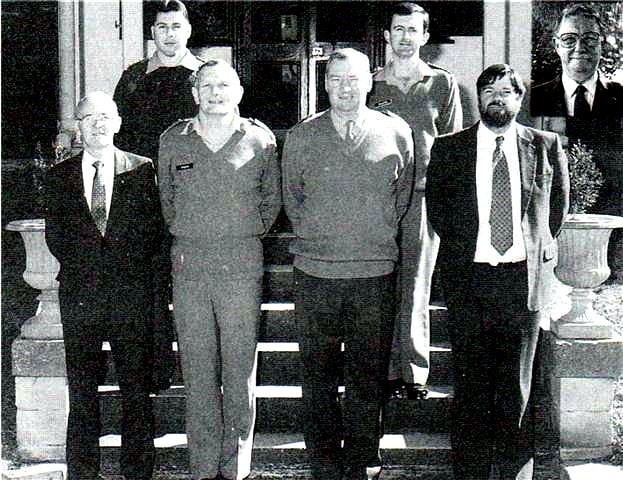
Capt S.J. Bagnall (Treasurer) Maj T.J. Rogers (Secretary) Brig J.O. Furner Brig S.V.L. Willis (Commandant) Maj Gen F.J. Hickling (Chairman) Mr T.P.A. Harrison Brig A.R. Roberts (inset)
The Trustees normally meet twice each year. The funds of the Trust are audited by the RMC regimental audit board.
RMC Archives
The inaugural Harrison Memorial Lecture was presented to the staff and student body at Portsea in November 1982 by Lt Gen Sir Thomas Daly KBE CB DSO on the topic of leadership. In succeeding years it was presented by Sir Roden Cutler VC AK KCMG CBE, General Sir Arthur MacDonald KBE CB and Admiral Sir Anthony Synnot KBE AO. It has been continued in subsequent years after the fusion at Duntroon, the lecturers being successively Sir Richard Blackburn OBE, General Sir Francis Hassett AC KBE CB DSO MVO, Sir Eric Neal, Maj Gen T.F. Cape CB CBE DSO, Sir John Holland AC, Maj Gen D.M. Butler AO DSO, Sir John Overall CBE MC*, Lt Gen Sir Leonard Thornton KCB CBE, Mr L.M. Jarman, Sir Edward Dunlop AC CMG OBE, General Sir Martin Farndale KCB, Mrs F.W Statham MBE ARRC ED, Mr J.B. Leslie AO MC, Sir William Keys AC OBE MC and Lt Gen J.M. Sanderson AC. A compilation of these lectures up to 1992 was arranged by the previous secretary, Maj C.G. Wrangle (4). The lectures continue, the history objective of the Trust is now effected by this volume, leaving the question of an OCS Society.
An association of graduates seems to have been first proposed in an exchange of correspondence between 1952 graduate A.R. Roberts and Chief Instructor Lt Col T.C. Bannister in November 1972 (5), however this foundered on the difficulties of finding an organising base and locating potential members well dispersed in both military and civil life. In consequence the question of an association has been long unresolved and might have remained so. Closure of the School seemed to place a limitation on the ongoing viability of a formal association, and the dispersal of graduates, serving and non-serving, throughout the country and indeed throughout the world, placed a real limitation on activities. They have long been eligible to join the Duntroon Association, as have the graduates of OTU Scheyville, a situation given real meaning since the amalgamation of both institutions. And although this is divergent from the basic instinct of a group whose memories lie at Portsea, the difficulties of establishing a viable association with wasting and dispersed numbers seemed fairly insuperable, particularly when other avenues of association were open and more specifically identifiable and attractive.
One of the proven attractions has been class reunions. The first to make the move was unsurprisingly the first course which held a reunion around the Portsea silver jubilee parade associated with the graduation of June 1977. The success of this spurred succeeding commandants to invite classes to participate as their 25th anniversaries came up, and this became a regular feature of each graduation celebration (6). This however has not satisfied the impatience of some; with 10 year anniversary reunions now becoming common. As nostalgia sets in more classes are keeping class lists and arranging for their next excuse to get together from the diverse locations and occupations to which they have gravitated. The venue was naturally Portsea until closure of the School, after which any venue which seems to suit the majority suffices; some still go back to Portsea, others choose the Canberra graduations, and some find Sydney convenient. The largest group of overseas graduates is comprised of the 398 from New Zealand; a high percentage of their army’s officer corps, they also have the advantage of proximity to Australia, closer to Portsea, Canberra or Sydney than are many Australian graduates in outlying areas, and this is reflected in their high attendance at class reunions.
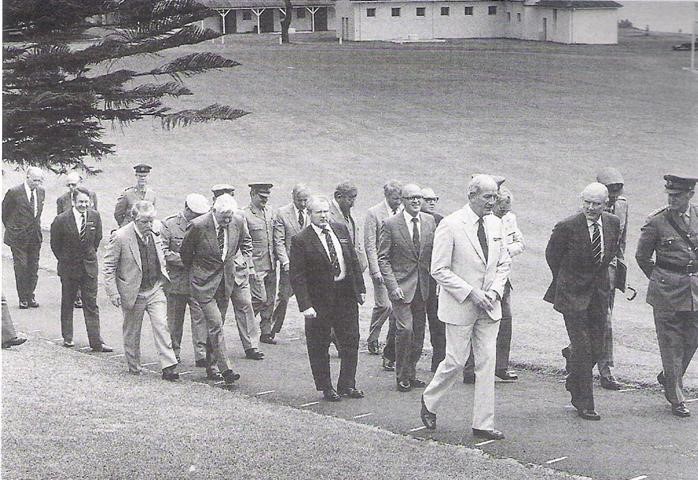
Graduates from the first course returned as guests of the School at the silver jubilee graduation parade on 10 June 1977, reviewed by Roden Cutler VC, trying the pace ladder under less trying circumstances than of yore.
This reunion opened the door for successive classes to follow suit on their 25ths, later joined by much later classes, which thought it such a good idea that they didn’t want to wait that long, and began the growing custom of celebrating their 10th anniversaries of graduation.
RMC Archives
Graduates in other overseas armies are faced with even greater problems of association, given the few numbers and isolation from even the opportunity of class reunions. Philippines alumni have tried to overcome this by forming a Graduates of Portsea Association and additionally belong to the Alumni of Royal Military Schools for graduates of Commonwealth officer training establishments including Australian, Indian and United Kingdom academies, but even so the few numbers and dispersion throughout their country reduces opportunities for meetings to occasional gatherings when some are in the same location for some reason. Australian Military Attaches in the Philippines have added to this by hosting dinners for OCS graduates in Manila. On the other hand graduates in the Fiji, Papua New Guinea, Brunei and Singapore armed forces have constant contact with each other because of the concentrated nature of their forces, and so have little need for a formal association, seeing each other as a matter of course. The Fijian graduates foresee the need for an association after the bulk of them retire and lose the regular contact found during service (7). Other national groups of alumni are generally too few for there to be any useful connection, while some belonged to armies no longer in existence after the conclusion of civil wars.
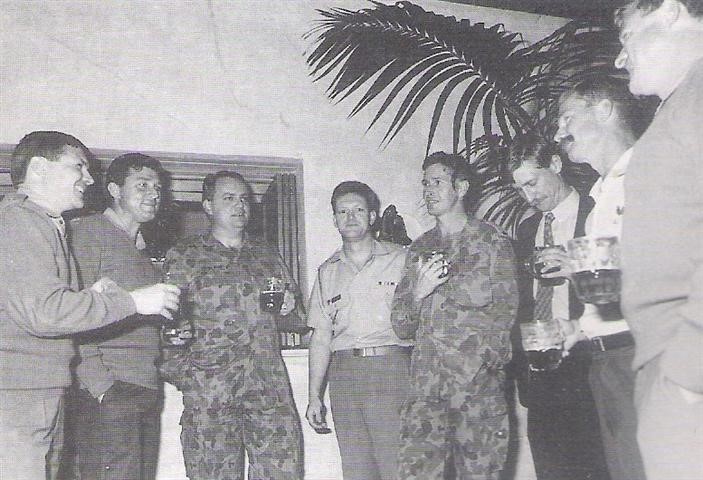
A 15 year get together of the Class of June 1980 located in Canberra was held in the Royal Military College Officers Mess, two of the members being instructors at Duntroon.
From the left:
B.M. Armstrong, D.A. Harris, G.E. Osborne, D.W. Belham, M.L.F. Spencer, D.A. Knaap, D.R. Morgan, J.S. Meier
Such groups are able to meet at regular intervals, while others are at more sparsely populated posts or have been absorbed into the community throughout the country, relying on the more formal anniversary reunions to get together again.
Photo: G.E. Osborne
For the Australian graduates, the final move to publish an history has proved a catalyst. The Trust has now decided that the time is right to activate a form of association but in view of the consolidation of officer training at Duntroon, it considered that using the existing mechanism and newsletter of the Duntroon Society provided the best avenue which was likely to be sustainable in the longer term. However, recognising a desire amongst graduates to retain a unique identification with their own alma mata, the Trustees decided to sponsor a Portsea Chapter of the Society, with the inclusion of a quota of OCS-specific material in the Duntroon Society newsletter. Newsletter content on OCS is seen as being at the core of keeping a Portsea Chapter vibrant, as it will not only be able to publish reminiscences of a type not suitable for this history, but also act as a contact medium to trace ex-classmates and advertise class and regional activities to all the members. The Trustees expect and hope that this will both meet their third objective and establish an ongoing link between graduates, especially as they progressively leave the army and find the opportunity for occasional class and special occasion get togethers.
OCS Journal
While it might have been expected that such an apparent luxury as a journal would not be at the forefront of priorities in the early days and short courses of the School, it would have been remarkable if the claim made in the June 1971 Journal to be the first ‘after twenty years of literary oblivion’ was correct. Once the full year course had been instituted, with its inclusion of a substantial element on written communication, and some time to allot to extra curricula activities, it would have seemed appropriate to add a dimension to both the course and stature of the institution with a magazine-type publication to at least mark the passage of each class and its doings. Indeed this was the case; in late 1955 commandant Col T.F. Cape decided that an annual journal should be published and so the Journal of the Officer Cadet School came into being through student editor R.K.S. Ross. Unfortunately, after the initial issue it faded from sight to the extent that when chief instructor Lt Col D.V. Smith pushed into being the OCS Journal in June 1971, the apparent silence from the past made it seem a belated groundbreaking initiative rather than the more than timely reestablishment of a lapsed activity.
Fortunately thereafter it became a bi-annual fixture, though it was not until the closing period of the School that it regained the quality of content exhibited in the initial journal and then under the period of Smith supervision. It did, however, remain a record of the institution’s activity, particularly of the graduating class and the sporting activities, but it is a great pity that the output of the course’s 100-plus hours on Communication Skills could not have founded a range of material worthy of publication to demonstrate some of the intellectual strength of the student body as a regular event. As with the early journal, its production was in the hands of an editorial committee of a staff officer and cadet editor and secretary, but supervision was so lax that in the mid-1970s the editor was allowed to graduate and escape the School before delivering the goods in publishable form. At the end of July 1975 the supervisor was able to report that the June and December 1974 and July 1975 issues were unpublished; it got worse, with Journal Officer Capt K.D.H. Felsche reporting in February 1985 a backlog of eight issues from June 1981. Although he made an effort to retrieve the situation, none has appeared for December 1980 or June 1981. The cadet editorial staff tended to match the growth in school staff: from an initial Journal Corporal in 1971, it finished with a Journal Sergeant and two Journal Corporals in 1985, though at least this latter effort produced some result from the past chaos, and a substantial and well presented final issue for December 1985 which was the credit to the School that the previous issues should have been (8).
Corps Traditions and Customs
As something of a latecomer to the world-wide fraternity of officer training academies, Portsea would naturally find it difficult to establish traditions and invent unique customs in a field well combed over by the others. In addition the early instructors’ experience of officer training establishments was largely conditioned by RMC, and their general experience lay in the wartime army. The foundation of customs was therefore predetermined until some later circumstances provided the opportunity for inventiveness or piracy from other institutions, though this was much delayed by the initial sequential six month courses, where it was the task of instructors and assistant instructors to pass to each class those actions, activities and expressions which they considered useful or necessary. It was not until the courses were extended to a year, with overlapping classes, that the internal organisation of the student body took ascendancy, customs were passed on and developed and a tradition established.
Changing the Days to Go board – 1953
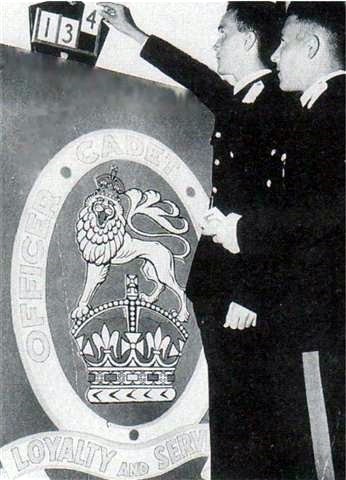
The task of the junior member each night at mess, marking the countdown to graduation of the senior class: P.B. Roden does the change, I.B. Bates supervising. A board was first looted during a visit to Point Cook but had to be returned, so the COC had its own made.
OCS Scrapbook 1953
One of the first customs adopted was an obvious one: anticipation of graduation. A days-to-go board was adopted from RMC-RAAF Academy practice as a visual record of the passing course. A supplementary habit of celebrating the last days of the course, taken from the 40 days to go at RMC, which incorporated public ‘this is your life’ exposes of senior class members, was adapted for the earlier 22-week OCS courses to 28 days to go. The initial lack of a senior class to humiliate led to fancy dress parades being held, but the advent of overlapping classes established the opportunity for offensive activity by a junior class as a payback for earlier indignities from their seniors, so this was extended to embrace internal warfare as well as usual celebrations. At some times 50 days to go was adopted but 28 was the most popular, coming before final field training, and being effectively the end of academic work for the term. A wide range of activities involving wrecking rooms, water fights and fancy dress turnouts proliferated before the serious business of preparing to go out to several weeks in the bush for their final tests of competency under practical conditions.
At some stages there was virtually no internecine strife or ragging tolerated by the cadets themselves for various reasons, in the early courses and later on usually in the smaller and more cohesive classes, but it always revived as different groups found the energy and sometimes malice to get at their juniors, seniors or peers. Peer discipline or exuberance erupted in the form of bishing, a not too subtle term for inflicting good spirited discomfort, and sometimes not so good spirited humiliation, on other cadets given such widespread pretexts as birthdays, establishing dominance or just simple retaliation. The custom went through various phases, first appearing as a rubbish bin of water surreptitiously tipped over a junior sleeping cadet; it then developed through more thorough and obnoxious wettings to the final finesse of the victim being strapped to an iron bed, decorated like a birthday cake, engulfed in garbage, then doused in Port Phillip. Shortened versions of this were visited on BSMs, CSMs and platoon sergeants after a successful day on the inter- or intra-unit sporting fields when, coxswain-like, they were thrown into the bay on the way back (9).
Mutual Harassment
Lost room rediscovered
1972
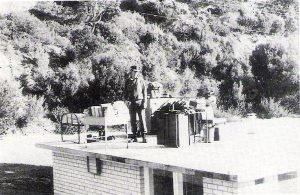
An officer cadet looking as lost as his mislaid room, after eventually finding it on top of the cadets’ laundry.
This was a more amusing way of getting at a fellow cadet – the simply destructive ones of wrecking a room so that there were hours of work restoring the clothing and equipment to inspection order, with actual damage to possessions, arose from time to time and seemed to be inbuilt into particular classes.
Fortunately more stable classes acted as a circuit breaker in what would become a chain of escalating viciousness which could have led to the problems of other military colleges world wide.
OCS Scrapbook 1972
The Bear Pit: pre-bishing finesse
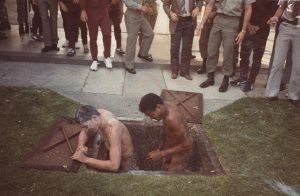
S.P. Collard and E.M.B. Manulevu in the stormwater trap which doubled as a holding pen for those awaiting their turn at a bishing.
OCS Scrapbook 1982
Bishing
1985
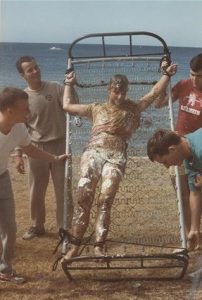
First female to receive the attentions of her fellows in preparation for a trip to the bay.
OCS Scrapbook 1985
Some habits were simple borrowings from other institutions. That of throwing caps high in the air at graduation was taken in the 1960s directly from the West Point practice. Others were very much of the home grown variety and in consequence arose progressively and sometimes faded as the years went on. Company flags were developed in the 1980s, but have not been retained in the collection handed on to RMC. A Company called themselves Aardvarks, the first A in any directory, and dubbed B Company-ites Bimbos. The mascots Aardvark for A Company and Bruce the Lion for B Company were created as internal symbols for display at unit sports, and were subject to kidnappings for the purpose of extracting ransom, or to be humiliated as a symbol of mastery over the other company. Such dominance of course was really established in the fields of military and sporting performance, as epitomised in the Rowell Shield and Harrison Cup, however as in all academic institutions, other symbols and horseplay are a usual part of high spirits in the relaxation process at intervals during demanding courses.
Corps Mascots
Mascot Blanco, Dixie or Ginger Dog
1953
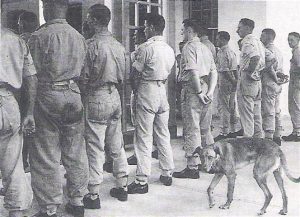
Protégé of instructor G.G. Jarman, it accompanied him everywhere in his battered 1939 Ford V8 known as The Equipment. Here on mess parade with A.R. Trevarthen, J. Glynn, R.Y. Porter, R.B.McN. Donaldson, K.F. Houley, D.D. Graham, L.A. Power, J.D. Geeves, K.E. Gallasch, J.F. Miller, K. Woods, D.R.H. Harris.
Photo: L.A. Power
Threat and counter threat
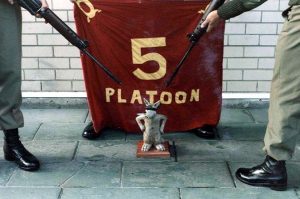 |
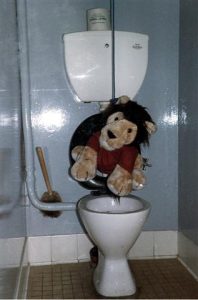 |
Captive mascots Aardvark and Bruce the Lion have their humiliation recorded to taunt their owners.
OCS Scrapbook 1982
Graduating Class Celebrating the End of Their Course – 8 December 1967
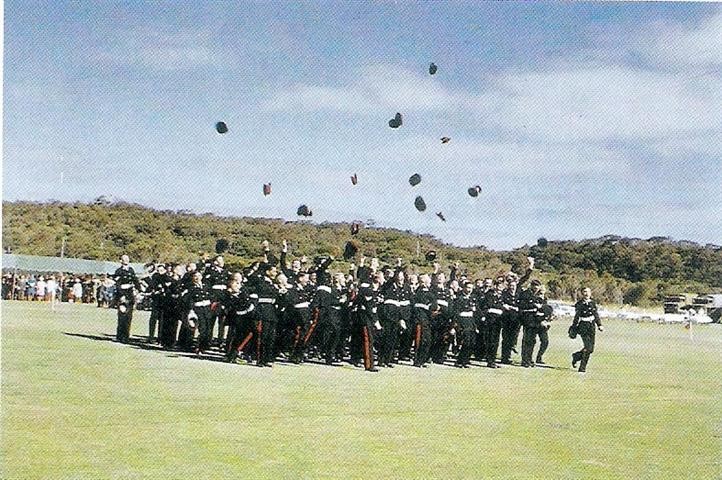
Originally held on Portsea town oval, then on to Jarman Field when it was developed, parades were held on the parade ground when it was built in 1955. With the enlarged classes of the 1960s this ground could no longer cope, consequently graduation parades returned to Jarman Field, then back to the parade ground, finally to Jarman again.
The graduates sought a means of expressing their exuberance in completing the course successfully, casting off the shackles of a demanding year spent in achieving their ambition to gain a commission in the Australian Regular Army. The West Point habit of throwing their caps in the air provided the least harmful solution.
Photo: P.D. Asbury
Punishments were recorded in a punishment book, as a finesse of rubbing salt into the wound, usually by the cadets who received them. As a celebration of the end of the reign of terror under which extra drills, confinement to barracks, stoppage of leave and show parades were inflicted for any misdemeanor, participants at the last ED parade for the term were allowed to parade in any garb they chose, and were marched into the sea at the end of it by the RSM. The cadet who had received the greatest number of punishments – and he and others may have still owed the system unrequited EDs – was allowed to throw the punishment book off the cliff into the bay (10).
Last ED Parade – 1975
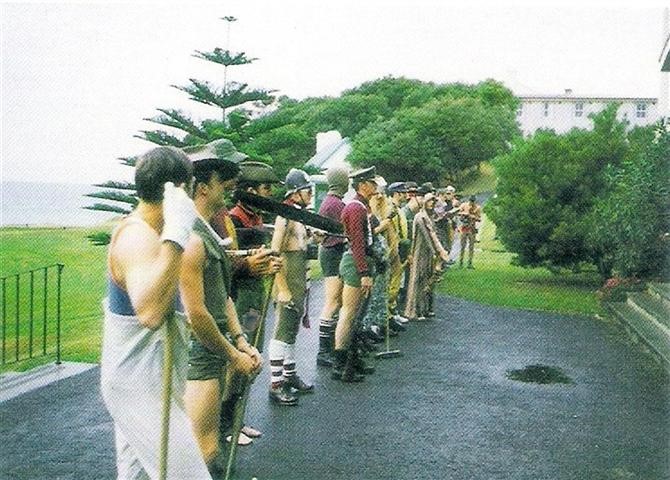
Deadly serious for all of the rest of the year, the last defaulters took on a festive air, with those doing their final punishment appearing in whatever garb they elected and could muster.
Tradition also had the RSM, who had to put up with this defilement of standards, marching the miscreants into the sea at the end of the parade.
Fancy and odd forms of dress, also evident at days to go celebrations, at concerts, in leaps training and competitions and other odd times, played a noticeable part in life at Portsea, perhaps a reaction to the rigours of immaculate turnout usually applied.
Photo: K.S. Fraser
Other customs abounded. Casper was a worse for wear Sherman tank located at the road junction leading to the School from the defence road: the elevating mechanism of its gun was still operative and this facilitated a custom of adjusting it to indicate the level of cadet morale, the barrel being raised or lowered according to the current feeling. A standard question asked of new cadets was how much water ‘the tank on the hill’ held. This was light hearted enough, but some other questioning sessions were designed to either stop junior cadets from eating or delay them from getting about preparing their gear for the morrow or making their way to the canteen. Sporadic staff attempts to circumvent this sort of unnecessary hazing had temporary success only, the problem resurrecting itself in other forms with the passage of time and changes of cadets and staff (11).
Casper at Tank Junction
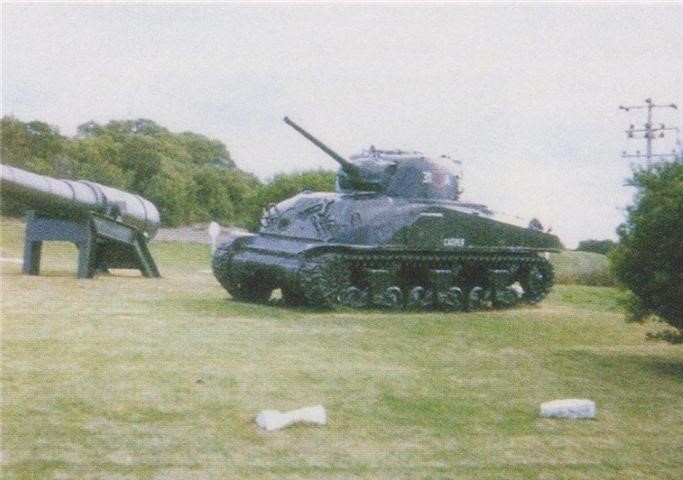
A Sherman tank, collocated with a gun barrel resurrected from the forts, found a practical use in the angle of the tank’s gun being used as an indicator of morale in the COC. Casper was retired to the tank museum at the Armoured Centre at Puckapunyal in 1986.
Photo: T.J. Gibbings
Freedom of a city or shire is a tradition whose origins are lost in time, but stems from free cities which had the walls to match the denying of entry to armed bands whose intentions they suspected. In recent times this has become a ceremonial event usually granted to a unit with a longstanding geographic affiliation with a municipality, and usually with an eye to the commercial benefits of such an event. After initial offers in 1971, 1975 and 1984 which were not followed up, Rye Chamber of Commerce proposed that OCS be granted Freedom of the Shire of Flinders prior to the Rye Limeburners Festival in May 1985, rather late in the day for a School due for relocation to Canberra, but at least a parting gesture. After some difficulties between the Chamber and Shire were ironed out, the freedom ceremony was held conjointly with the Victorian Sesquicentenary celebrations on 18 May 1985, Flinders Shire Chairman doing the honours, the Corps of the Company of Officer Cadets exercising its rights once and for all, and a civic reception held afterwards at the Rosebud Returned and Services League (12).
Any organisation tends to adopt or acquire a vernacular which is appropriate to its function, operations and environment. This is particularly marked in army organisations, with an hierarchy of phraseology stemming from international and national standardisation of terminology, national army expressions influenced by those absorbed from contact with other armies, and also corps and unit special circumstances which generate their own unique sub-culture added on to the foregoing. The resultant vocabulary in an organisation is therefore not unique, rather an amalgam of standard and common expressions, some adapted to different meanings, with an overlay of local patois, some of which borrowed from or adapted to the local scene. As an army academy the underlying basis at Portsea was obviously army patois, incorporating a mixture of technical expressions inherited from the British Army, together with slang words from RMC and many which Australian expeditionary forces garnered from their overseas sojourns in the Mediterranean, Europe and East Asia either directly through contact with the local populations or from British and US army members who passed on their world wide accumulation of adopted words and lingua francas. To this the officer cadets added some words and meanings of their own to eventually develop a vocabulary which, if not completely distinctive, had its own hallmark matching the institution. Not that this was static. As the compendium of Cadetspeak in the third part of the Glossary demonstrates, there were changes of meaning through the life of the School. Cadetspeak is a product of the contributions and revisions by respondents and represents their best recollections. There can be no doubt that memories up to forty years old have both created some distortions and admitted contamination of words and meanings acquired from earlier or later periods and other places, however there has been some audit by the sample of graduates who added to and reviewed the list.
Notwithstanding this there will always be dispute for the previously mentioned reasons. Some of the distortions which arose during compilation amply demonstrate historians’ assertion that oral tradition becomes worthless factually within an hundred years. For example: Toc, the expression for morning tea (taken from RMC where it signified the morning or supper beverage) was asserted by a 1983 OCS graduate to be an acronym for ‘Tea Or Coffee’, when it was in fact letter T=Toc in the wireless telegraphy phonetic alphabet used until the 1950s, exemplified in the TocH organisation of World War 2. In one generation the origin had been replaced by a plausible make up, though the compiler of Duntroon Slang also noted that a similar metamorphosis of the word had taken place there during the 1970s.
Martial Music
Military music plays an intrinsic part in the ceremonial of a military organisation. The OCS establishment did not provide for a band, nor did that of RMC until the federal department buildup in Canberra called for one for diplomatic purposes, when the RMC band was raised in the mid 1950s. There was no such convenient opening for OCS, however Army bands proliferated. The regimental band of the Royal Melbourne Regiment provided for the first graduation parade in June 1952, and with the Army School of Music just down the road at Balcombe, and the Army Apprentices School Band likewise, it was usually possible to get an effective band when required. But after the appearance of the Flinders Naval Depot Band in June 1958, the Southern Command Band performed continuously at graduation parades for a decade until the June 1967 appearance of the Royal Australian Armoured Corps Band, which put in a repeat performance two years later. To further the variety, the Pipes and Drums of the Pacific Islands Regiment was made available in December 1968, followed two years afterwards by the Pipes and Drums of the Second Battalion of PIR combined with the Lae Area Band. Thereafter the Southern Command Band, renamed 3rd Military District Band in 1973, again became the mainstay (13).
The Southern Command Band Inspected by Visiting Prime Minister of Malaya
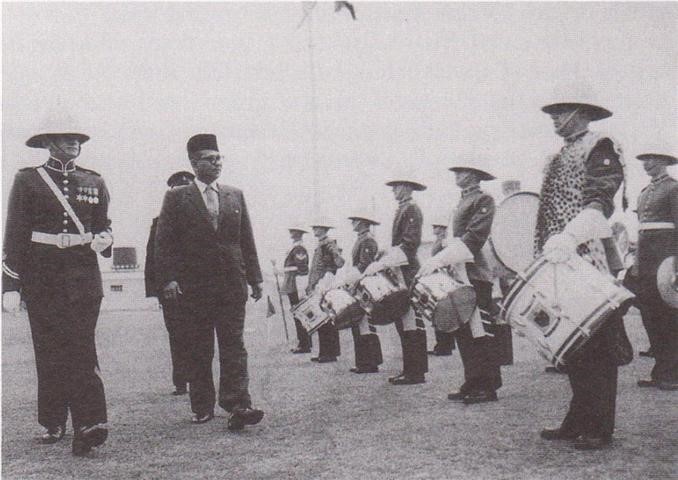
The Southern Command Band was the regular one used for ceremonial parades. Other local and imported bands filled out other occasions, including two visits from Pacific Islands Regiment Pipes and Drums.
Other parades, ceremonial training and rehearsals were carried out to recorded music, often much the worse for wear.
OCS Scrapbook 1959
Significant military organisations are prone to nominating a special piece of music as their regimental march. Many in the Australian Army have unfortunately simply taken on the march of a British unit; others have taken such a march and added a distinctive Australian flavour; and the more astute have acquired an original piece of their own. OCS simply used marches in the normal band repertoire until 1964 when Lt Col R.A. Newman, long time army Director of Music from 1951 to 1971, composed a special piece for the COC. The result was the Corps’ quick march Portsea. To complement this, he also recommended as a slow march one composed by Kenneth J. Alford in the mid-1930s with the appropriate title By Land and Sea, which was duly adopted (14).
Portsea
By Land and Sea
The words of the quick march, as is the case with most anthems and official songs, are of dubious merit and are best celebrated by disuse, leaving the music to speak for itself:
We are from P-o-r-t-s-e-a the only school
L-o-y-a-l-t-y Loyalty the golden rule
S-e-r-v-i-c-e To fight and serve without regret
Raise up your glass and drink
‘To the Company of Officer Cadets’
The COC also used The Carnival is Over as a corps song, adapting words endlessly as events demanded or provided opportunity. Then each of the companies took a song of its own: A Company adapted the music of Men of Harlech under the title Men of Portsea with the not very inspiring words:
Here within the wall of Portsea
There is one Company only
That will make the other ordinary,
Company on parade.
Bimbos always shirk from battle,
But with us the sabres rattle,
And that’s not just tittle-tattle,
Company on parade.
et cetera
B Company, not to be outdone, and equally immodestly, took on a song from the much-admired rock band Queen called We are the Champions, the words sufficing without amendment. They and an OCS haka were all also used on occasion as School songs at sporting events, where hopefully the inadequacy of the singing concealed most of the words from the opposition’s supporters (15),
With no regular military musicians available, Reveille and Last Post bugle calls were played over the public address system by the cadet duty officer. As the atmosphere of the School became more relaxed it became usual to replace the official calls with music of the duty officer’s choice. A standard one after the Board of Studies meetings was another of Queen’s songs Another One Bites the Dust (16), an apparently callous approach to the demise of some of their classmates, but such is human nature in stressful situations, whether gravediggers, medical practitioners or officer cadets on the knife edge, that black humour helps the psyche cope with the seamier side of their life.
References
- AA B2453/1R310/1/4 Pt 5 of 28 March 1969.
- Harrison Memorial Lecture Trust Deed, s.A, s.4.
- Trust Deed, s.7.
- Wrangle ‘Harrison Memorial Lectures’.
- AA B245311 R133/2/40 of 13 November 1972.
- AA B2453/1 R274/3/23, R274/3/26, R274/3/27, R274/4/1 passim.
- Letters M.C. Webster, Alex C. Capina, Juanito W. Dalmas, HQ Fiji Military Forces 10/38 of January 1994.
- OCS Journal June 1971, p5; Journal of the Officer Cadet School 1955 Editorial; AA B2453/1 R696/1/10 passim.
- Letters P.D. Coward, N.J. Hughes, N.D. Irwin, R.C. Stevenson, M. W. Trafford.
- Letters K.S. Fraser, F.D.L. Greenway, A.A. Nicolic.
- Cameron ‘Autobiography’ p216; Letters J.A. Harriot.
- AA B2453/1 R2741318 passim.
- AA B2453/1 R723/1/1 OCS Reports passim; R133/5/5 of 21 November 1968.
- AA B245313 21/1/1 of 21 September 1965; Letters HQ CSC fax 216195 of 23 June 1995.
- Letters HQ CSC fax 216/95 of 23 June 1995, W.S. Jolly, J.A. Harriot.
- Letters I.W. Coombe, T.A. Grutzner.